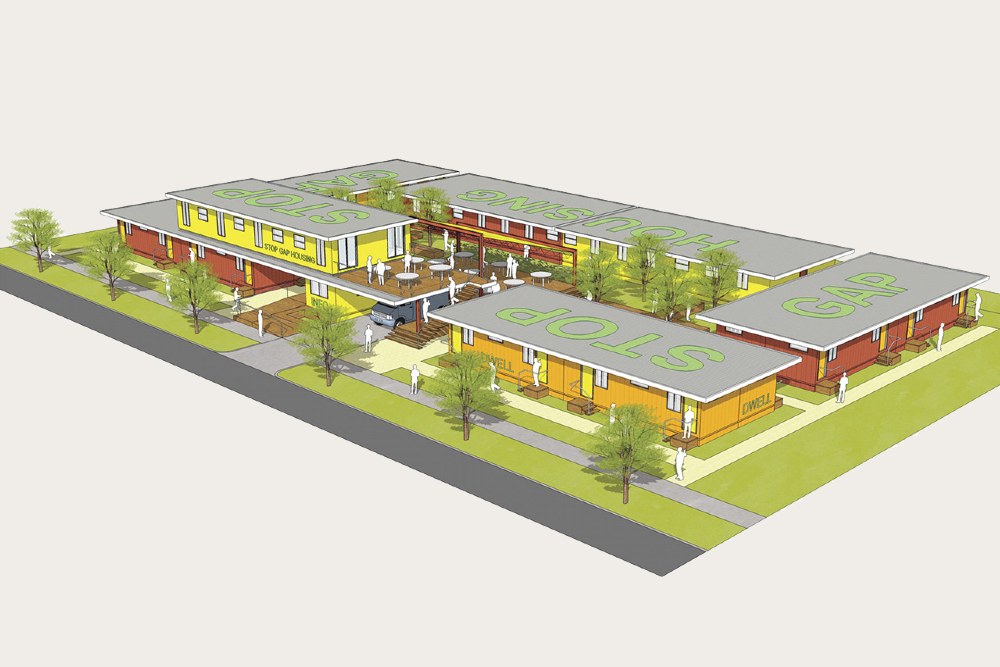This article was first published by Street News Service.
A plan to house Vancouver’s homeless is taking shape on the drawing board of a local architect. It calls for the rapid erection of temporary villages assembled from the same type of modular units that mining companies provide for remote workers.
‘Stop Gap Housing’ is what architect Gregory Henriquez calls it. “All of us in this community have long been advocates for permanent housing,” he said. “But we’ve gotten to the point where the numbers of homeless are so staggering that I’m left wondering if we will ever catch up doing it that way. I don’t think we can. I think there has to be a stop-gap measure. And that’s what this is.”
Henriquez, whose Woodward’s project includes 200 units of social housing built to last hundreds of years, stressed that Stop Gap Housing would never replace permanent homes.
“It’s portable dwellings. It’s not meant to be a permanent fixture on the landscape. But it could serve for several years until we complete the construction of permanent housing,” he said. “I think it’s better than leaving people homeless.”
It’s also cheaper. Numerous studies suggest that this sort of housing would save [British Columbia (B.C.)] taxpayers hundreds of millions of dollars a year in police, ambulance and health expenses.
Colorful villages
Remote resource extraction companies have been using these modules to create spartan camps for decades.
“They use these all over the Athabaska tar sands,” Henriquez said. “They call it workforce housing.”
Henriquez took plans from Britco Structures, which operates plants in Agassiz and Penticton, and showed them to managers from the Portland Hotel Society, which rents to hundreds of the Downtown Eastside’s hardest-to-house individuals.
The Portland team suggested that individual units—with ensuite bathrooms and fronts that open directly to the outdoors—would be more acceptable to individuals not accustomed to coping with neighbors, as well as to those reluctant to give up pets or bicycles.
Henriquez drew up plans for a motel-like village, with 48 suites clustered around a central courtyard. The colorful compound includes a manager’s office, a covered patio and a second story meeting room all within a typical 120-by-200-foot city lot.
“The hard part is to make it pretty and nice. But we can do that. We’re good at that stuff,” Henriquez said. “You paint it some bright colors. You make it as festive as you can. And you house people with dignity.”
Speed is beauty
“The speed at which we can accomplish this is the essence of its beauty,” Henriquez said. “The big issue has to do with permitting,” Henriquez said. “For a normal social housing building, you might need rezoning, then you need a development permit, then a building permit. That takes years.”
But Stop Gap Homes would rest on wooden blocking, not permanent foundations.
“These can all be done through temporary permitting,” Henriquez said. “It’s a 12-month permit that can be renewed.”
“We’ve talked to Britco. They have excess capacity because a lot of the oil sands stuff has been cancelled. They could build hundreds of these things within months,” Henriquez said.
Saving tax dollars
Henriquez is preparing a plan to erect 1,000 units of Stop Gap Housing on eight city sites in less than a year.
If combined with the reopening of almost shuttered hotel rooms recently identified by the Carnegie Community Action Project, the Stop Gap plan would provide enough homes to house nearly all of the 1,547 individuals found in Vancouver during the spring 2008 homeless count, and leave hundreds of shelter beds left over for the newcomers expected to arrive as the 2010 Winter Games approach.
And the cost of building those 1,000 units would be less than what the city and province are currently paying to administer to those same people on the street.
B.C. taxpayers currently spend an average of $55,000 per year in health, corrections and social services for each of the estimated 11,750 homeless people in the province, according to a 2008 study by SFU’s Centre for Applied Research in Mental Health and Addiction. That’s $644 million a year to maintain homelessness.
Modular homes such as Stop Gap Housing could be built for less than $40,000 per unit according to estimates.
VANOC: work on similar project
The idea makes so much sense that VANOC is already spending about $18 million to create 320 modular housing units as workforce housing at the Olympic Village in Whistler.
The total cost of the VANOC project, which is co-sponsored by Britco and RONA, is budgeted at $43.6 million.
Henriquez, in partnership with the Portland Hotel Society, is in preliminary discussions with a leading local developer to bring the Stop Gap proposal before the city.
He figures the total cost of 1,000 units will also run somewhere in the ballpark of $40 million.
And he hopes that Vancouver’s business leaders will join with socially responsible Olympic sponsors as well as the federal and provincial governments in ponying up that cost.
“We need leaders with real courage. This isn’t somewhere we wanted to go,” Henriquez said.
“But I think there are not a lot of choices. If we don’t act quickly, more people will die. And this is within our means… We can end homelessness this way.”








